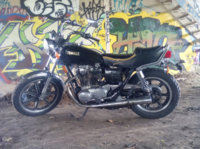gnarlybynature
XS650 New Member
hey guys & gals,
Just registered on the forum, but I have surfed through a couple times looking for advice.
I've been riding a 1981 xs 650 for about 3 years, my first bike, and I can't get enough. I'm no mechanic but am learning as much as I can. Over the time I have had the bike I have been replacing parts as needed, and it's finally running like a real champ this summer. I am going to try to ride from Philadelphia to Denver in a couple weeks - hoping to not get into too much trouble along the way. Have done a number of 200-300 mile rides before but none like this!
replaced the pushrod in the clutch, new cables, new rear sprocket, tires and chain. Replaced oil and air filters, little rubber grommets and seals. Mechanic at my local shop cleaned out the carbs, adjusted valves, cam chain and ignition points. I'm waiting for some parts in the mail to get my speedo/odometer back on track. The 'speedo clutch' in the drive of the front wheel was busted but seems like a pretty easy fix.
got some leaky fork seals that will need to be replaced, but I'm thinking I might just add oil as I go, if needed. Maybe there's someone along the way/in colorado that knows what they are doing? haha I haven't tried to take apart the forks yet. (most of the work I have been doing is on the sidewalk )
)
Just wanted to give a "howdy" to the community and see if anybody has any horror stories about similar rides.
Just registered on the forum, but I have surfed through a couple times looking for advice.
I've been riding a 1981 xs 650 for about 3 years, my first bike, and I can't get enough. I'm no mechanic but am learning as much as I can. Over the time I have had the bike I have been replacing parts as needed, and it's finally running like a real champ this summer. I am going to try to ride from Philadelphia to Denver in a couple weeks - hoping to not get into too much trouble along the way. Have done a number of 200-300 mile rides before but none like this!
replaced the pushrod in the clutch, new cables, new rear sprocket, tires and chain. Replaced oil and air filters, little rubber grommets and seals. Mechanic at my local shop cleaned out the carbs, adjusted valves, cam chain and ignition points. I'm waiting for some parts in the mail to get my speedo/odometer back on track. The 'speedo clutch' in the drive of the front wheel was busted but seems like a pretty easy fix.
got some leaky fork seals that will need to be replaced, but I'm thinking I might just add oil as I go, if needed. Maybe there's someone along the way/in colorado that knows what they are doing? haha I haven't tried to take apart the forks yet. (most of the work I have been doing is on the sidewalk
 )
)Just wanted to give a "howdy" to the community and see if anybody has any horror stories about similar rides.


